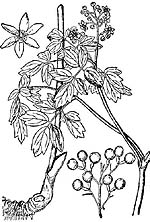Blue Cohosh for the Childbearing Years

With all the current media news about black cohosh for use in menopause, the herb blue cohosh has been almost overlooked. The properties of blue cohosh (caulophylum thalictroides) make it the perfect herb to use during the childbearing years.
Blue cohosh is an American herb, found growing in the eastern United States along streams and swampy areas. The root — or rhizome — of the plant is the key to the wonderful properties of this herb.
Before pregnancy, blue cohosh is an excellent tonic to tone the uterus. It can also be used in larger doses to jumpstart a delayed period or one that is abnormally light, although it will not trigger a spontaneous abortion. Blue cohosh is also said to relieve cramps and some PMS symptoms.
During pregnancy, blue cohosh is used as an anti-spasmodic to ease the threat of premature labor, false labor and miscarriage during early pregnancy. Blue cohosh should not be taken during mid-pregnancy, unless miscarriage or premature labor is threatened. Native Americans used the herb to help ease delivery when the fetus had reached full term by using it as a tonic when the mother reached within a few weeks of the expected birth.
After birth, blue cohosh can be taken to relieve colic in an infant and to treat flatulence and gastrointestinal cramping. Blue cohosh works to lessen the effect of convulsions and spasms caused by chorea, epilepsy and other diseases.
Blue cohosh has also been used in the treatment of rheumatoid arthritis, although there are other herbs that may work better in the treatment of this disease.
Blue cohosh works best in combination with other herbs. To strengthen the uterus, combinations of blue cohosh, false unicorn root, motherwort and yarrow are the most common. To receive the anti-spasmodic effects, skullcap or black cohosh along with blue cohosh are often used.
Blue cohosh, if taken in recommended doses, is a safe herb for many of the problems women face during the childbearing years. Like many herbs, it is available in powdered, capsule and tincture form. The dried powder can be taken as a tea, using no more than a teaspoon to a cup of hot water. The tincture recommendations are 5 - 10 drops in a cup of water.
While blue cohosh may not be as easy to find as black cohosh, the benefits are well worth the search. During the childbearing years, this herb can work wonders to help a woman's body to be at its reproductive best.
|